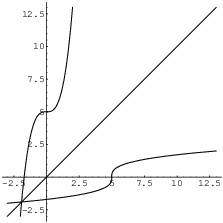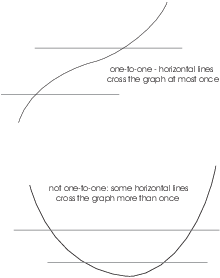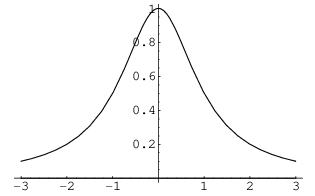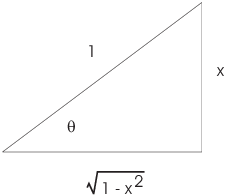Functions ![]() and
and ![]() are inverses if for all
are inverses if for all ![]() and
and ![]() ,
,
![]()
If f has an inverse, it is often denoted ![]() . However,
. However, ![]() does not
mean "
does not
mean "![]() "!
"!
Example. Show that ![]() and
and ![]() are inverses.
are inverses.
![]()
Notice that the inverse of ![]() is not
is not
![]() !
!![]()
Example. Suppose f and ![]() are inverses and
are inverses and ![]() . What is
. What is ![]() ?
?
![]()
Example. Let ![]() . Find
. Find ![]() .
.
First, switch x's and y's:
![]()
Solve for y in terms of x. The result is ![]() :
:

Since the inverse ![]() is obtained from
is obtained from
![]() by swapping x's and y's, the graph of
by swapping x's and y's, the graph of ![]() is a mirror image of the graph of f across
the line
is a mirror image of the graph of f across
the line ![]() :
:

Not every function has an inverse. For example, consider ![]() . Now
. Now ![]() , so
, so ![]() should take 4 back to 2. But
should take 4 back to 2. But ![]() as well, so apparently
as well, so apparently ![]() should take 4 to -2.
should take 4 to -2. ![]() can't do both, so there is no inverse! The problem is
that you can't undo the effect of the squaring function in a unique
way.
can't do both, so there is no inverse! The problem is
that you can't undo the effect of the squaring function in a unique
way.
On the other hand, if I restrict ![]() to
to ![]() , then it has an inverse function:
, then it has an inverse function: ![]() .
.
A function f is one-to-one or injective if different inputs go to different outputs:
![]()
A graph of a function represents a one-to-one function if every horizontal line hits the graph at most once.

A one-to-one function has an inverse: Since a given output could have only come from one input, you can undo the effect of the function.
Calculus provides an easy way of telling when a function is one-to-one, and hence when a function has an inverse.
Definition. A function is (strictly) increasing if
![]()
That is, bigger inputs give bigger outputs.
A function is (strictly) decreasing if
![]()
That is, bigger inputs give smaller outputs.
A function which is (strictly) increasing on an interval is one-to-one, (and therefore has an inverse). A function which is (strictly) decreasing on an interval is one-to-one (and therefore has an inverse).
For example, suppose f is increasing on an interval, a and b are
points in the interval, and ![]() . One of the two
is larger; suppose
. One of the two
is larger; suppose ![]() . Then
. Then ![]() . In particular,
. In particular, ![]() . Therefore,
f is one-to-one, and has an inverse.
. Therefore,
f is one-to-one, and has an inverse.
A similar argument works if f is decreasing.
We'll see later that a differentiable function increases on an interval if its derivative is positive, and decreases on an interval if its derivative is negative. This will give us an easy way of telling where a function has an inverse.
Example. Let ![]() . Show that f has an inverse for
. Show that f has an inverse for
![]() or
or ![]() .
.
I have
![]()
![]() for
for ![]() and
and ![]() for
for ![]() . So f increases for
. So f increases for ![]() and decreases for
and decreases for ![]() .
.
It follows that f is one-to-one (and has an inverse) on ![]() or on
or on ![]() .
.

As you can see, either the left half of the graph or the right half
of the graph would pass the horizontal line test. But the whole graph
does not.![]()
Theorem. Suppose f is differentiable and
either strictly increasing or strictly decreasing on an interval ![]() . Suppose
. Suppose ![]() ,
, ![]() , and
, and ![]() . Then
. Then ![]() is differentiable at y, and
is differentiable at y, and
![]()
Proof. Since f is either strictly increasing
or strictly decreasing on an interval ![]() ,
, ![]() exists and is defined on the
interval
exists and is defined on the
interval ![]() , Suppose
, Suppose ![]() and
and ![]() . Then
. Then

Example. The inverse sine function satisfies
![]()
![]()
Derive the formula for ![]() .
.
The derivative of ![]() is
is
![]()
Let ![]() . Then
. Then ![]() :
:

Thus, ![]() , so
, so
![]()
Example. If ![]() and
and ![]() , find
, find ![]() .
.
![]()
Example. Suppose ![]() , so
, so ![]() .
Differentiating directly,
.
Differentiating directly,
![]()
Confirm this using the formula for the derivative of the inverse.
To use the formula for the derivative of the inverse, note that ![]() . Therefore,
. Therefore,
![]()
The results are the same.![]()
Example. Suppose that ![]() and
and ![]() .
Find
.
Find ![]() .
.
Since ![]() ,
, ![]() . So
. So

Example. Let ![]() . Notice that
. Notice that ![]() . Find
. Find ![]() .
.
First, ![]() . Then
. Then
![]()
Copyright 2018 by Bruce Ikenaga